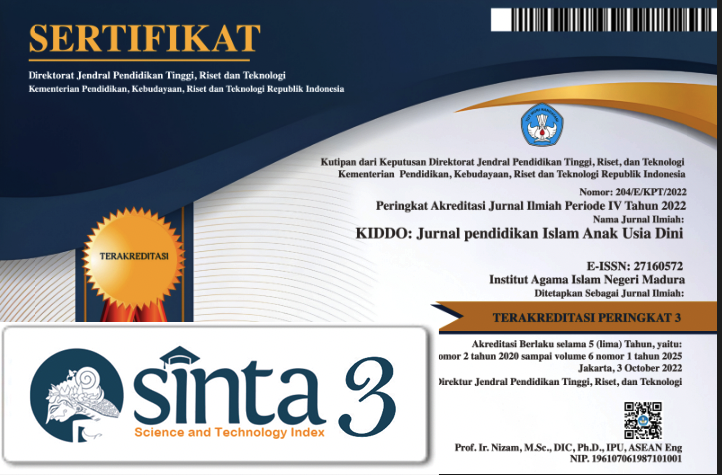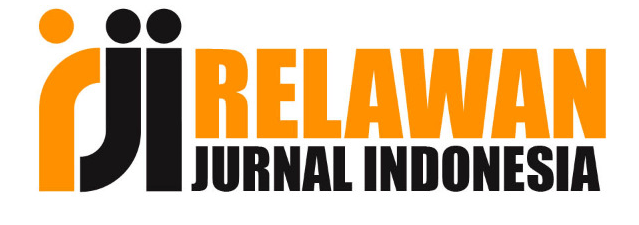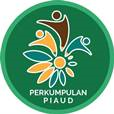Penerapan Buku Dongeng ”Bermagi Jadikan Anak Berbakti” Berbasis Profil Pelajar Pancasila dalam Pengembangan Karakter Anak Usia Dini
 Abstract views: 218
,
Abstract views: 218
,
 PDF downloads: 129
PDF downloads: 129
Abstract
This research aims to analyze the effectiveness, advantages, and disadvantages of using the book "Magical Tales Make Children Devout" based on the Pancasila student profile at TK Kusuma Bangsa. The research employed a qualitative study with a case study approach. Data collection procedures involved observation, interviews, and documentation, aligned with the research focus. Data analysis in this study included data reduction, data presentation, and drawing conclusions. The results of the research demonstrate that the use of the book "Magical Tales Make Children Devout" based on the Pancasila student profile at TK Kusuma Bangsa, through a habituation process, proves to be effective. It enhances children's engagement in learning and their understanding of Pancasila values embedded in the stories. The strength of this fairy tale book lies in the content based on the Pancasila Student Profile, making it a recommended reference material for teachers as it has brought about tangible positive changes in shaping Pancasila values in children. While there are shortcomings in the use of this fairy tale book, including uniformity in story types and some stories being perceived as brief or lacking depth when depicting situations and Pancasila values, it can be confirmed that the use of the book "Magical Tales Make Children Devout" has a positive impact on children at TK Kusuma Bangsa. This includes the potential for character development, increased understanding of Pancasila values, and a heightened interest in learning
Downloads
References
Farantika, D., Shofwan, A. M., & Purwaningrum, D. (2022). The Benefits and Purpose of Storytelling for Early Childhood Education. SINDA: Comprehensive Journal of Islamic Social Studies, 2(2), 122–129. https://doi.org/10.28926/sinda.v2i2.497
Fitroh, S. F., & Sari, E. D. N. (n.d.). DONGENG SEBAGAI MEDIA PENANAMAN KARAKTER PADA ANAK USIA DINI.
Habsari, Z. (2017). DONGENG SEBAGAI PEMBENTUK KARAKTER ANAK. BIBLIOTIKA : Jurnal Kajian Perpustakaan dan Informasi, 1(1). https://doi.org/10.17977/um008v1i12017p021
Hayati, R. (2019). IMPLEMENTASI PENDIDIKAN KARAKTER CERDAS FORMAT KLASIKAL (PKC-KA). 9(1).
Indahsah, I., Arifin, I., & Arafik, Muh. (2023). Implementasi Pendidikan Karakter Melalui Metode Montessori pada PAUD di Lingkungan Pesantren. Journal of Instructional and Development Researches, 3(3), 119–130. https://doi.org/10.53621/jider.v3i3.233
Kusmiadi, A., Sriwahyuningsih, S., & Nurfalah, Y. (2008a). STRATEGI PEMBELAJARAN PAUD MELALUI METODE DONGENG BAGI PENDIDIK PAUD. JIV-Jurnal Ilmiah Visi, 3(2), 198–203. https://doi.org/10.21009/JIV.0302.11
Kusmiadi, A., Sriwahyuningsih, S., & Nurfalah, Y. (2008b). STRATEGI PEMBELAJARAN PAUD MELALUI METODE DONGENG BAGI PENDIDIK PAUD. JIV-Jurnal Ilmiah Visi, 3(2), 198–203. https://doi.org/10.21009/JIV.0302.11
Maharani, L. A., Furnamasari, Y. F., & Dewi, D. A. (2021). Menumbuhkuatkan Pengetahuan Mengenai Nilai-Nilai Pancasila di Sekolah Dasar. 5.
Maulida, U. (n.d.). PEMBENTUKAN KARAKTER ANAK MELALUI DONGENG PADA PEMBELAJARAN INTEGRATIF.
Maunah, B. (2016). IMPLEMENTASI PENDIDIKAN KARAKTER DALAM PEMBENTUKAN KEPRIBADIAN HOLISTIK ANAK. Jurnal Pendidikan Karakter, 1. https://doi.org/10.21831/jpk.v0i1.8615
Priya, A. (2021). Case Study Methodology of Qualitative Research: Key Attributes and Navigating the Conundrums in Its Application. Sociological Bulletin, 70(1), 94–110. https://doi.org/10.1177/0038022920970318
Rahayu, T. E., Hariyani, H., & Ferlia, R. (2022). Children’s Language Skills Through the Illustrated Story Method in Kindergarten. TEMATIK: Jurnal Pemikiran Dan Penelitian Pendidikan Anak Usia Dini, 8(1), 18. https://doi.org/10.26858/tematik.v8i1.27539
S, S., At, A. M., Atmoko, A., Hidayah, N., Shafie, A. A. H., & Deliani, N. (2021). NILAI-NILAI KARAKTER DALAM KABA MINANGKABAU SABAI NAN ALUIH: KAJIAN HERMENEUTIKA. International Virtual Conference on Islamic Guidance and Counseling, 1(1), 22–40. https://doi.org/10.18326/iciegc.v1i1.50
Sardiana, E. (2020). Volume 1, Nomor 1, September 2020. 1.
Umairi, M. A. (2023). Pengembangan Interaksi dan Perilaku Sosial Terhadap Pendidikan Anak Usia Dini di Abad 2. 4(2).
Wahyuni, S., Sumarsono, R. B., Desyanty, E. S., & Asimiran, S. B. (2021). Analysis on Management’s Managerial Competence and Its Influence on Pos-PAUD Service Quality. Journal of Nonformal Education, 7(1), 47–54. https://doi.org/10.15294/jne.v7i1.27257
Badan Pusat Statistik (BPS). (2023). Statistik Indonesia 2023. Jakarta: BPS.
Bruner, J. (1991). The narrative construction of reality. Critical Inquiry, 18(1), 1-21.
Center on the Developing Child, Harvard University. (2022). Brain Architecture. Retrieved from https://developingchild.harvard.edu/science/key-concepts/brain-architecture/
Durlak, J. A., Weissberg, R. P., Dymnicki, A. B., Taylor, R. D., & Schellinger, K. B. (2011). The impact of enhancing students' social and emotional learning: A meta-analysis of school-based universal interventions. Child Development, 82(1), 405-432.
Eder, D., & Holyan, R. (2010). Life lessons through storytelling: Children's exploration of ethics. Indiana University Press.
Fukuyama, M. (2018). Society 5.0: Aiming for a New Human-Centered Society. Japan SPOTLIGHT, 27, 47-50.
Heckman, J. J., Pinto, R., & Savelyev, P. (2013). Understanding the mechanisms through which an influential early childhood program boosted adult outcomes. American Economic Review, 103(6), 2052-86.
Kementerian Pendidikan dan Kebudayaan. (2020). Peraturan Menteri Pendidikan dan Kebudayaan Nomor 22 Tahun 2020 tentang Rencana Strategis Kementerian Pendidikan dan Kebudayaan Tahun 2020-2024. Jakarta: Kemendikbud.
Kohlberg, L. (1981). Essays on moral development: The philosophy of moral development (Vol. 1). San Francisco: Harper & Row.
Listyarini, I. L., Sari, D. P., & Sutopo, D. (2020). The effectiveness of storytelling method to improve children's understanding of honesty value. Jurnal Obsesi: Jurnal Pendidikan Anak Usia Dini, 4(2), 518-525.
Mar, R. A., & Oatley, K. (2008). The function of fiction is the abstraction and simulation of social experience. Perspectives on Psychological Science, 3(3), 173-192.
Piaget, J. (1952). The origins of intelligence in children. New York: International Universities Press.
Rideout, V. (2017). The Common Sense census: Media use by kids age zero to eight. San Francisco, CA: Common Sense Media.
Santrock, J. W. (2021). Life-span development (18th ed.). McGraw-Hill Education.
Schwab, K. (2016). The fourth industrial revolution. Geneva: World Economic Forum.
Shonkoff, J. P., & Phillips, D. A. (Eds.). (2000). From neurons to neighborhoods: The science of early childhood development. National Academies Press.
Suryanto, S. (2017). The implication of local wisdom-based story telling through mobile gaming to build early childhood character. International Conference on Education and Science (ICONS 2017). Atlantis Press.
UNICEF. (2023). A familiar face: Violence in the lives of children and adolescents. New York: UNICEF.
Widodo, S., Wardani, S., & Permatasari, I. (2022). Implementation of Pancasila Student Profile in Early Childhood Education Curriculum: A Case Study. Jurnal Obsesi: Jurnal Pendidikan Anak Usia Dini, 6(3), 1658-1669.
Copyright (c) 2024 SITI FATIMAH SITI FATIMAH

This work is licensed under a Creative Commons Attribution 4.0 International License.
-
The journal operates an Open Access policy under a Creative Commons 4.0 International license. The terms of the license are:
Share— copy and redistribute the material in any medium or format
Adapt— remix, transform, and build upon the material for any purpose, even commercially.
1. Authors retain copyright and grant the journal right of first publication with the work simultaneously licensed under a Creative Commons License.that allows others to share the work with an acknowledgement of the work’s authorship and initial publication in this journal
2. Authors are permitted and encouraged to post their work online (e.g., in institutional repositories or on their website) prior to and during the submission process, as it can lead to productive exchanges, as well as earlier and greater citation of published work (See The Effect of Open Access).
Jurnal Kiddo is licensed under a Creative Commons
n Access).














